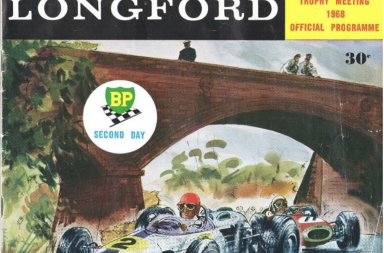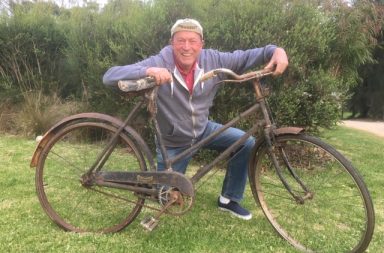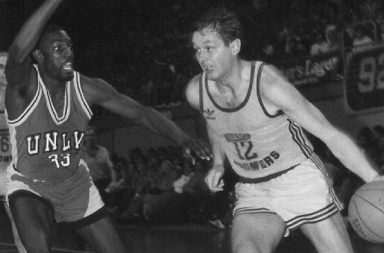By NEIL KEARNEY
EVER heard about the time that three blokes in Longford (Tasmania) yarned over the phone with Bing Crosby? Well, it happened at closing time in the bar of the Blenheim Inn in 1952. Publican Jock Connell was sharing a few cleansing ales with barber Arch Walters and woolclasser Tom Talbot when they decided to try to get the famous crooner on ‘the blower’. They rang the local telephone exchange at the northern Tasmanian town and, surprisingly, the operator obliged their far-fetched request, connecting them via a series of exchanges both sides of the Pacific, and eventually the boys in The Blenheim heard Bing’s voice down the line from America. “We had a good old chat,” Talbot recalls. Did you really talk with Bing Crosby? “Yes, it was him.” This tale might seem a long stretch, but anyone who has known Tom and Archie would agree that nothing was beyond those two. I’ve travelled far and wide as a television and newspaper reporter, yet the most interesting person I know is the bloke who lived at the end of my street in the Tassie town where I grew up. For 49 years Thomas Jeffrey Talbot and his wife Judy owned a weatherboard house in Hay Street Longford, raising three children, Bridget, John and Simon. The school playground was at one end of our street and the town’s rubbish tip was at the other. We played on both. Nearly all of the great and garrulous characters from those days on Longford have gone now, but Tom is as effervescent as ever. He’s short in stature, yet he’s larger than life. His abundant enthusiasm and rapid speech can sometimes seem comical, but that’s Tom. He’s an original and he’s the most positive man you’ll ever meet. Born in 1930, Tom approaches every day with the zest and energy of a pre-schooler. First up, he completes the paper puzzles to keep his mind sharp. What’s 25 multiplied by 12 divided by 6 plus 2 reduced by 50 per cent? Give up? Tom doesn’t. He gets them every time. He’s a voracious reader – always has two books on the go – and there isn’t a local event that Tom doesn’t support or an organization in which he isn’t actively involved. “I try to stay interested and connected,” he explains. Tom is very humble, but he’s a people person par excellence. “I like to find the good in people. If you treat them well, and you get them talking, the goodness comes out. I’ve been very fortunate that my life, including my working life, has revolved around people.” Tom’s earliest years were at Evandale – his dad was head stockman at Pleasant Banks, a farm which once fell into the soft hands of yours truly. Tom says: “I remember the first time I smelt sheep manure in the old barn at Pleasant Banks. We were catching ewes in the lambing sheds. I must have been three or four. I loved it.” This was the early 1930s, during the great depression, when many country schools were closed because of the polio epidemic. Tom’s parents were so concerned they sent him and sister Shirley to be isolated on the Nile – near Deddington Tasmania, not Cairo Egypt. Each day they walked two and a half miles from their temporary lodgings to attend the Nile school and they wore a camphor block around their necks, purportedly to ward off polio. When he completed schooling, Tom started with Tasmanian Woolgrowers, sweeping floors, dusting shelves and wrapping parcels. To gain experience and to see a bit of the country, he worked in shearing sheds across South Australia, up in the Flinders Ranges, where the flies are as ornery as the rams. Tom laughs about the long drop loos, which accommodated several shearers in a line, all doing their business. “You could be sitting side-by-side with your worst enemy,” he laughs. In 1947 he started wool classing. There’s no need to prompt Tom on where that was. “Bentley, Chudleigh, for John Humphries,” he says, quick-as-a-flash. Of course Tom remembers every detail. Who needs Google when you’ve got Tom’s memory? He used to travel the 60km from Longford to Chudleigh every Monday morning with two other local identities, ‘Golfie’ Barker and Wally ‘Bronc’ Ellis. ‘Golfie’ drove the jalopy, ‘Bronc’ clung onto the passenger’s side door because it wouldn’t shut, and Tom was stuck in the middle. They laughed all the way. One day ‘Golfie’ called into Skippers’ general store at Chudleigh with the intention of buying a tyre for his truck. He came out ten minutes later wearing a sports coat. The sleeves were embarrassingly short – halfway up his hairy forearms. But ‘Golfie’ was very proud of his new clobber. “How do I look?” he asked his mates. “Fits you like a glove,” Wally smirked. These were the post-war years when wool was king and shearing sheds abounded with colorful characters and raucous camaraderie. For Longford folk, this was the heyday of the Mill Dam reserve, when families flocked to the riverbank to swim, play, enjoy picnics and pick blackberries. One day Tom was swimming with Mike Barnes when Mike’s dad Dick, who ran the kiosk, pointed out a small group of girls sitting on a grassy bank. Tom was smitten by a lass in a red swimsuit. Some time later, Tom suited up for the shearers’ ball in the old hall at Cressy, 12km south of Longford. Tom admits he was the worst dancer in the hall – but he could talk. Tom took a deep breath and asked for a waltz with the pretty young woman he’d seen in the red swimsuit. This time she was wearing a cream evening frock and she looked even more beautiful. Judy Shackloth and Tom Talbot got married in Christ Church at Longford on the 17th of December 1955. They enjoyed 53 years of happy marriage. Sadly, Judy passed away on the 8th of November 2008. In 2004 the couple had moved to a lovely new home on the eastern side of Longford, where Tom now lives. The Talbots’ first house was built by their neighbor and friend Peter de Bruyn snr and Tom’s current home was built by Peter’s son Frits. Tom likes the symmetry from generation to generation. He gets on just as well with young people as he did with their parents, grandparents and great grandparents. There are many properties around Tasmania where – as a wool-man of over 70 years standing – Tom has worked with four generations of the same family. In Tom’s humble opinion, there are four men in history who he rates above all others. They are Winston Churchill (“his command of words was so good”), Donald Bradman (“perfection”), Longford football champion Terry Cashion (“the best player in Australia in 1950”) and Essendon’s legendary high-flier John Coleman. Tom and Longford mates Brian Scott and Ray Booth sneaked into the Essendon rooms at the MCG immediately after the Bombers won the 1950 VFL grand final, in which Coleman kicked four goals. “It was very crowded, they’d broken the gates down earlier in the day, but we grabbed the doorman’s arm and told him we’d come all the way from Tassie, so he let us in. We heard all the speeches and then we donated ten shillings each – they called us out and said thanks to the three young fellas from Tassie”. Tom’s love of sport is infectious and his stories have filled many an evening in the life of this writer and my late brother Graham, who thought the world of Tom. The remarkable athletic prowess of Mick Goss was often espoused by Tom, who saw the Bishopsbourne farmer win the mile at Latrobe one Boxing Day after giving the frontrunners a full lap start in the four lap race. Mick trained alone on the paddocks of his farm 10km from Longford to become the world professional two-mile record-holder. Tom has always liked to run, and therein a lies a story. On the evening of April 4th 1957 Tom Talbot was running laps of the Longford recreation ground. He was 27. Tom has always treated his running seriously, and rarely takes his eyes off the ground in front him. But on this evening he noticed a vehicle parked in the shadows alongside the football oval and he clearly recalls the car had a taxi light on its roof. Tom was running around the footy ground in an anti-clockwise direction and he saw the taxi light flicker on and off. He ran four more laps and then jogged the four hundred metres to his Hay Street home, thinking no more of what he had seen. The following day the body of Launceston taxi driver Ivo Joseph Skelly was found in a ditch near the entrance to Woolmers Estate, one of Tasmania’s oldest pastoral properties. Skelly had been battered about the head – apparently by a hatchet. The Skelly murder was the most notorious crime in the history of the Longford district. Police took years to apprehend Skelly’s murderer, who had been a passenger in the taxi. The culprit was charged in Wollongong, New South Wales. Tom regrets he didn’t step forward to tell police what he had seen that evening at the recreation ground. “I didn’t think a lot about it at the time,” Tom, who will turn 88 in July, says. “I didn’t reckon that what I had seen mattered. But I wonder whether the murder may actually have been committed at the football ground. Of that we’ll never know”.
Throughout his colorful life, Tom has had more than his share of misadventures. He has survived no less than a dozen accidents. In 1961 he drove a shiny new Vanguard. He had been visiting Barney Gatenby at Bicton (between Campbell Town and Cressy) and on his way out he paused momentarily at the farm entrance. “I looked right when I should have looked left,” Tom says. A log truck collected Tom’s Vanguard, but both drivers were lucky and neither was seriously hurt. As Tom says, the Vanguard wasn’t destined for a long life. The Talbots lived near my family’s home in Hay Street and Tom drove back-and-forth to Launceston each day. Longford wool presser Cyril Brunton often travelled with him, but one evening in July 1961 Cyril rang Tom to say he wouldn’t be riding with him next morning when Tom was going to Launceston’s Killafaddy stock sales. This proved to be a wise decision by Cyril, and fortuitous for Tom. There had been heavy rainfall in the previous week and floodwaters were rising. But on this morning, the surface conditions were especially hazardous – there was a sinister black frost. Who was to know how slippery the old Kings Bridge would be at seven o’clock in the morning? As Tom approached the bridge, he was startled by a car coming the other way. It was swerving, seemingly out of control. A few seconds later, Tom’s Vanguard slid into the railing on the left side of the bridge and plunged into the icy waters of the South Esk river. As the Vanguard sank to the bottom, Tom realised that the rear window had popped out, quite possibly after hitting the side of the bridge, and water was rushing in. The pressure was so intense, all he could do was lie on the front seat of the Vanguard and wait for it to fill with water. From the bridge, motorists noticed the broken railing and they looked over, hoping to see bubbles. Somehow, Tom had the presence of mind to free himself, climb over the front seat into the back and swim out. He was then swept downstream by the current. He says he’s never been so happy to end up in a patch of blackberries at the river’s edge. Naturally, Tom’s wife Judy and small children Bridget and John were mightily pleased to see him again. Cyril Button was relieved, too. Cyril was a tall man with long arms and legs – Tom says he was “like a tarantular”. If Cyril had been sitting alongside Tom that morning, Tom is convinced that neither of them would have got out alive. It wasn’t long before the story of Tom Talbot’s dip in the South Esk became part of local folklore. But that wasn’t Tom’s last foray into misadventure. On a rainy night in 1984 he was driving home from Waterhouse in Tasmania’s north-east when his car slipped over the edge of The Sidling. The trunk of a huge eucalypt down the hillside saved Tom from an awful demise, and he walked away from another close call. Tom later came to grief on his push-bike. He used to ride a lot to keep fit – pedaling to 20 or 30 kilometres at a time to places as far away as Bracknell, Liffey and Carrick. One day Tom attended the funeral of another much-loved Longford identity Leo Palmer and afterwards he decided to go for a ride on his old Malvern Star, wearing his towelling hat beneath his helmet. It was a very hot day and something got in his eyes as he rode along High Street Longford – he didn’t see the parked car that he rode into the back of. Tom wisely made the decision that he would be safer on foot than on wheels, so he took to jogging. With his pronounced running action and loud breathing he could be seen and heard from far away. But one rainy night in 1997, when he was running to a hospital meeting at Longford’s Foresters Hall, he was struck by a car. “I went up and down the bonnet, but no bones broken”. He still walks between three and five kilometres each day, wearing his bright-colored safety vest. And he’s been known to finish his exercise with a cold shower.
Between accidents, Tom had a very rewarding working life. He carved a unique niche, starting with Tasmanian Woolgrowers on the first of January 1946 and finishing with Websters on Christmas Eve 1996. He worked for the company for fifty years plus 24 days. Throughout rural Tasmania, the name Tom Talbot is an institution. He has judged wool at shows around Australia, including the Sydney Royal in the Olympic year, and Longford show wouldn’t be the same without the ubiquitous presence of Tom Talbot. Even though he’s been retired for over twenty years and Websters merged with Roberts Limited in 1997, he is still considered part of the Roberts family. With loyal friends such as Andrew Calvert, Gilbert Davidson and Bob Barrenger, he visits properties around the island, acting as a roving ambassador. He has close relationships with many of today’s property owners and workers, just as he had with their forebears. “I like looking at the sheep, especially during shearing time,” he says. “But it’s the people I enjoy most. They treat me so kindly and make me feel welcome. I’ve never had one day when I’ve regretted doing the job I’ve done”. Over the past two centuries, Longford has known many original characters whose achievements, humor and generosity of spirit have enriched their community. Because the diminutive Tom is so humble and unassuming, he would never stand out in a crowd, but his irrepressible optimism and good humour are inspirational. The moral of this story is that you should never take your neighbors for granted. The man, woman or child who lives at the end of your street could be the most interesting person you ever know. They might even have had a yarn with Bing Crosby.



